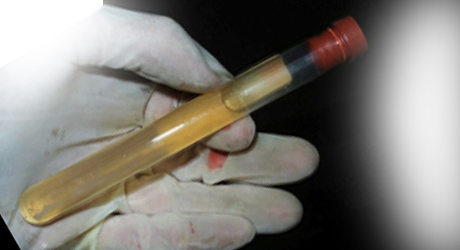Click here for examples of dogs successfully treated with the serum.
Alson W. Sears DVM copyright 2011
Note: Federal law prohibits the shipping of serum. However, a vet may make this serum in a clinic, store it there and treat dogs who are brought to that clinic. This is not an antibody serum. We believe it causes an immune response that creates a previously unknown material or group of materials. We are not sure how it works, but it works quickly when a sick dog is treated with this material in the early stages of the disease.
1. The following protocol is for the production of anti-Distemper serum.
2. This serum is used S.Q. for the elimination of Distemper virus in acutely infected dogs.
3. Early treatment is recommended. Less than 4 days of illness.
4. Treat for bacterial pneumonia for at least seven days!
5. Recovery of acute Distemper Disease is usually within 12 to 48 hours.
6. This is species specific but, can be induced and used in any other species that are susceptible to distemper or related diseases.
Process for making the NDV-induced serum (anti-morbillivirus serum)
1. DOG: Use a 10- to 12-month-old, mixed-breed dog, 60-100 lbs, 27.27kg to 40.91kg, young, unneutered and healthy.
2. Do full lab work-up to eliminate all possible health problems, especially blood-born diseases.
3. Must be previously vaccinated against all local diseases. Eliminate all parasites especially ascarids. If a dog has recently been dewormed, wait a couple of weeks after deworming so the immune modulators of the worms have a chance to disappear.
4. Do not use breeds or individuals known to have immune deficiency problems. (Demodex,Shar Pei’s)
5. Make up Newcastle Disease Vaccine 1000 dose vial. (Use only the 6 cc of diluent vial that comes with the NDV or Saline if Diluent is not available). Inject 6.0cc of Diluent or Saline into the NDV vial. Discard the balance remaining from the Diluent vial. Use La Sota strain. Other strains of this virus should work as well but do not use Killed Virus NDV Vaccine. Use Modified Live NDV. This virus is your cell immunity inducer.
6. Place IV Catheter in dog.
7. Inject 2.0 or 3.0cc of Newcastle virus I.V. from your vaccine bottle depending on the official weight of the dog. (Treat dog with I.V fluids accordingly) (Do Not use Corticosteroids or antihistamines)
8. Induction of Newcastle’s disease virus for cellular immune serum (possibly microRNAs) may only be done once on any dog. The second time around antibodies to Newcastle’s disease are produced and block the immune response. These antibodies are of no use. The immune substance produced is unknown and unnamed at that time.
9. Timing is absolutely essential for taking serum against distemper. Take blood 11-12 hours post injection (11-12 hrs post injection= Anti-viral factors=Very effective against Distemper Virus in VIVO.) Timing is important. (Interferon, antiviral, regulatory, anti-inflammatory cytokines all have different times of production).
10. All procedures must be sterile. Just prior to the 11-12 hours post- injection, anesthetize donor dog (approx. 5-10 minutes before).
11. Place Jugular catheter.
12. Start I.V. fluids.
13. Withdraw blood between the 11th and 12th hour and inject into 10cc blood vials [sterile no additive vials] and allow the blood to clot. All VETS please take out only up to maximum amount from donor dog. Remove blood just short of putting the dog into shock. That can be determined by the color of the gums and respiratory rate. What is amazing is the speed with which a healthy dog recovers. Fluids of course help recovery. We could take about 250 cc whole blood from a 90 lb dog and get about 100 cc of usable serum (A.W. Sears DVM 6/8/09)
14. Centrifuge immediately after clotting for clear serum. Do not allow RBC’s to lyse.
15. Remove serum and place into sterile bottles. This removes all cellular elements. T-cells, RBC’s, B-cells
16. Place serum bottles in baggies and store in refrigerator. Bottles of serum can be stored for up to five years in a refrigerator; longer if frozen.
17. Cryo-precipitates may form after refrigeration. Mixing causes clouding. This is not harmful.
18. May be filtered out with a .02 micron filter. Keep sterile.
19. All my donor dogs have survived. I have not lost any. Not one person on my staff has been harmed by this virus and procedure in the last 40 years.
Note: Revisions may be made as new data becomes available. If you have any questions, please contact Dr. Alson W. Sears DVM for further clarification at AntiDistemper@aol.com.
Dosage
From Dr. Sears: Dose of the serum depends on age of the dog. If for herpes, single shot 1 cc to each pup at birth. If for distemper of any age the dose is 1 cc per dog plus 1 cc per 10 lbs 12 hours apart for 3 treatments. So, 20 lb dog would be 3 cc sub Q 12 hours apart 3 times. for a 30 lb dog would be 1 cc plus 3 cc for a total of 4 cc given 3 times. UPDATE: Give the injection sub Q on the rear legs–left or right–anterior to the great muscle, NOT between the shoulders or neck area.
Treatment at presentation of acute upper respiratory disease.
Tamiflu–Turns out some of these other viruses are extremely sensitive to this medication. I would recommend that 1 mg/lb be given twice daily for at lease 7 days. Should block most of the viruses we are discussing.
Antibiotics.–All these viruses cause inflammation in the lungs. (flu causes hemorrhagic pneumonia) All leave a BACTERIAL SECONDARY PNEUMONIA. My recommendation is Penicillin -G and Baytril inj three times daily in older dogs 9 Mos or older for at least 10 days.
Penicillin -G and Chloromycetin (25 mg/lb) three times daily for 10 days in younger dogs. (Baytril causes joint problems in younger dogs)
Supportive fluids and feeding as necessary.
There is an effective test for these viruses developed and available through ANTECH. This is a throat swab that distinguishes the upper respiratory viruses and give a good diagnosis. Also for distemper there is still the transitional cell bladder test. Works great to diagnose acute distemper quickly.
There is a test for distemper antigen an intranasal swab that is done at the clinical level. Problem with this test is that it can and does go positive with vaccine distemper virus. So, it can and does give false positive tests for distemper and cause a misdiagnosis.
Bordetella is kennel cough. It is treated with cephalosporin antibiotics. It does not routinely cause pneumonia. Can be confused with the viral diseases. I DO NOT LIKE THIS CLASS OF ANTIBIOTICS FOR PNEUMONIA IN VIRAL DISEASES.
List of upper respirartory diseases that can and are confused with distemper
Parainfluenza
Adenovirus
Canine influenza H3N8
influenza H1N1
Mycoplasma
Corona virus
Herpes virus
Many bacterial pneumonias.
Treatment of secondary neurologic problems in dogs remains the same at this time. This problem is only seen in those dogs treated late in the disease or those that make a spontaneous recovery.
If you have any comments or recommendations please write to me and we can discuss them. I came to realize that a lot of the pneumonias that are reported are NOT distemper. Still need to be treated.
Distemper types
1. Young un-vaccinated dogs, usually from pounds. Dogs with all the recognizable symptoms i.e. pneumonia, catarrh, fever, diarrhea, collapse, inclusions in bladder. Elevated antidistemper IgG, IgM .
2. Mild nondescript diseases shows transient signs often not recognized in early stages, quick recovery, can be confused with kennel cough. The secondary symptoms appear later. I.E. chorea, demyelination, hard pad, nasal symptoms, pneumonia, ocular symptoms K/S and old dog encephalitis.
3. New Form of Distemper. Relatively rare- adult dog fully vaccinated multiple times breaks with some symptoms of distemper, the exposure factor unknown-possible wild species exposure. May be new strain of distemper.
4. Vaccine induced type- no pneumonia, no inclusions in body, seizures, and inclusions in brain. No other pathology found upon autopsy. Elisa tests for Distemper antibody of CSF (+), No inclusions in the bladder, no inclusions in conjunctiva. Do not use Distemper / Parvo combination Vaccines. Some dogs suffer from distemper inclusion encephalitis. No treatment that I know of available. Treatment Rx For types 1-2-3. Give lcc per 10pounds plus 1 cc per animal. Three treatments every twelve hours subcutaneously for 3 total treatments. For example 20 lb dog 2 cc + 1 cc Give 3 cc each treatment.
Give antibiotics for one week to control secondary symptoms of pneumonia. I have had best results with 2 separate antibiotics simultaneously. Give fluids to control shock on initial presentation. In desperate circumstances, in the absence of available serum, NewcastlesÕs vaccine can be injected IV, directly into sick dogs. If they are not already severally compromised by the distemper virus they can respond and recover from distemper. Results Complete cessation of all symptoms of distemper in 12-48 hours. Except for secondary bacterial pneumonia which must be treated for at least 7 days.
Opinion:
It has been my observation that animals treated early do not have secondary neurologic symptoms. I would recommend all dogs suspected of distemper have full white cell count, lab work. Run antidistemper antibody IgG, IgM to confirm distemper. An additional test to confirm distemper, do a brush border slide of the bladder transitional epithelium. Stain with Dif-Quick. About 90% of the bladder cells will be positive for inclusions in the early stages of distemper. Rarely inclusions can be seen in the red cells. I have never seen inclusions in the conjunctiva. An IFA test of the conjunctiva to test for inclusions is available. I have no experience with this test. It is best to initiate all the tests and then give serum. Wait for the test results after treating. If wrong no adverse reactions if right you are ahead of the game for stopping the virus. Dogs can be treated later in the disease, after 4 to 6 days, but the serum will not undo viral damage that has already taken place. It is therefore best to treat in the early stages, or with the first acute symptoms.
Fighting the distemper virus is only half of the battle. Here are some important notes from Dr. Sears.
If anybody has any questions please feel free to contact me. AntiDistemper@aol.com
UPDATE 5/27/2010 — FIRST SERUM MADE IN PUERTO RICO.

